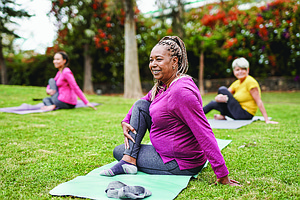11/7/2022

Nearly half of all American adults have high blood pressure, or hypertension, according to the Centers for Disease Control and Prevention. Of those, about 75% don’t have it under control, and many may not even realize they have it unless they experience other complications.
In fact, high blood pressure is a leading cause and controllable risk factor for heart disease and stroke as well as other issues such as kidney failure, vision loss and sexual problems. However, the American Heart Association recommends taking these simple steps to help control your levels and manage risks.
1. Know Your Numbers
In most cases, normal blood pressure is 120/80 mm HG or less. Readings consistently higher than 130/80 are considered high blood pressure. Have your blood pressure measured at least once a year by a health care professional and regularly monitor it at home with a validated monitor then discuss the readings with your doctor. Getting accurate readings can help ensure the most appropriate treatment should any problems arise.
2. Maintain a Healthy Weight
If you’re overweight or obese, you’re at increased risk of high blood pressure. Losing just 3-5% of your body weight can help improve your numbers. There are an abundance of plans and programs available that can assist with weight loss, and taking positive steps with a friend or family member may help with motivation.
3. Get Active
To maximize health benefits and help keep blood pressure in the normal range, the American Heart Association recommends adults get at least 150 minutes per week of moderate activity, 75 minutes of vigorous activity or a combination of the two. Try activities like brisk walking, swimming, bicycling or dancing. For example, the Get Down with Your Blood Pressure campaign uses music and dance to help remember the four easy steps to self-monitor blood pressure:
• Get It – grab your self-monitoring blood pressure (SMBP) device
• Slip It – slide the SMBP cuff up your arm
• Cuff It – wrap the cuff snugly, but not too tight
• Check It – check your blood pressure on the device
4. Eat Well
Making small, simple changes to your eating habits can go a long way toward keeping you and your family healthy. Eating fruits and vegetables, such as mangos, avocados and blueberries, can lower blood pressure over time. Other smart choices include nuts and seeds, whole grains, lean proteins and fish.
5. Reduce Alcohol and Tobacco Usage
Smoking compounds risk factors for heart disease, such as high blood pressure and diabetes, and the chemicals in tobacco smoke can harm your heart and blood vessels. Similarly, consuming alcohol excessively (more than two drinks per day) is associated with high blood pressure. Limiting alcohol consumption and stopping smoking – or avoiding secondhand smoke – can help reduce your risk.
If you develop high blood pressure, work with a health care professional to manage it, and visit heart.org/hbpcontrol to find local blood pressure resources, step-by-step self-monitoring videos and more.
Monitoring Your Blood Pressure at Home
Knowing how to correctly check your blood pressure is important, especially if your doctor recommends regular self-monitoring at home.
• Be still. Don’t smoke, drink caffeine or exercise during the 30 minutes before measuring your blood pressure. Empty your bladder and take at least 5 minutes of quiet rest time before measuring.
• Sit correctly. Sit with your back straight and supported. Keep your feet flat on the floor and your legs uncrossed. Support your arm on a flat surface, such as a table, with your bicep at heart level. Place the bottom of the cuff directly above the bend of your elbow. Never take measurements over sleeves or other clothing.
• Measure at the same time every day. For greatest consistency, take readings at the same time daily, such as a set time in the morning and evening.
• Take multiple readings and record the results. Each time you measure, take 2-3 readings approximately 1 minute apart and record the results to share with your doctor.
This project is supported by cooperative agreements (CPIMP201227 and CPIMP201228) with the Office of Minority Health (OMH) of the U.S. Department of Health and Human Services (HHS), as part of a financial assistance award totaling $14.6 million in partnership with the Health Resources and Services Administration (HRSA). The contents do not necessarily represent the official views of, nor an endorsement by OMH/OASH/HHS or the U.S. Government. For more information, please visit https://www.minorityhealth.hhs.gov/.
